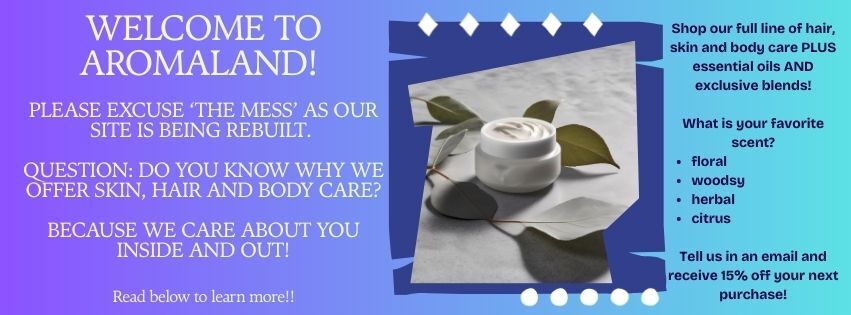Why your brain knows the difference between real and fake scents!
Posted by Tammy L. Davis on on Sep 25th 2025
The $50 Billion Secret That’s Been Hiding in Plain Sight
You walk into a luxury spa, breathe in that intoxicating “lavender” scent, and feel your stress melt away. Or do you? New groundbreaking research is revealing a shocking truth: your brain can tell the difference between true essential oils and alternative fragrances (from natural isolates to synthetics)—even when your nose can’t.
And the implications are staggering.
The Brain Scan That Changed Everything
The volunteers’ brains grew. Actual gray matter increased in regions controlling memory, emotion, and cognitive function. This was the first study in history to prove that scent can physically reshape your brain.
But here’s the kicker: this only happened with real essential oils, not synthetic fragrances.
The $50 Billion Deception
These synthetic scents can fool your nose, but they can’t fool your brain’s ancient wiring.
What You’re Really Buying:
“Vanilla” candles: Vanillin made from wood pulp or petroleum
-
“Lavender” bath salts: Synthetic linalool and linalyl acetate
-
“Peppermint” diffuser oils: Chemical menthol with artificial colorings
-
“Rose” perfumes: Up to 80 synthetic compounds mimicking one flower
The “Entourage Effect” Your Brain Craves
Synthetic fragrances? They’re like playing a single piano key and calling it Mozart—not unlike medications.
Why? Because science cannot replicate synergy, the entourage effect.
Real Lavender Oil Contains:
-
Linalool (the calming compound everyone knows about)
-
PLUS over 200 other compounds including:
-
Terpenes that enhance absorption
-
Esters that prolong the effect
-
Trace aldehydes that trigger specific brain receptors
-
Protective antioxidants that prevent degradation
-
Synthetic “Lavender”:
Linalool
-
Synthetic linalyl acetate
-
Petrochemical carriers
-
Artificial preservatives
-
That’s it.
Your brain evolved over millions of years to recognize these complex plant signatures. When it encounters a manmade substitute, it produces a different reaction.
The 15-Minute Brain Revolution
-
Blood pressure
-
Heart rate variability
-
Stress hormone levels
-
Brain wave patterns
-
Immune system markers
One study tracked participants using EEG machines while they inhaled essential oil blends. The results were remarkable: enhanced cognitive function, faster reaction times, and improved selective attention—benefits that didn’t occur with synthetic alternatives.
Why Businesses Are Scrambling to Catch Up
Luxury Hotels are ditching synthetic lobby scents for authentic essential oil diffusion systems, reporting increased guest satisfaction and longer stays.
Corporate Wellness Programs are incorporating clinical-grade aromatherapy, seeing reduced sick days and improved employee focus.
High-End Spas are investing in authentic essential oil treatments, charging premium prices for genuine therapeutic benefits.
Smart Retailers are educating customers about the difference, building loyalty through transparency and results.
The Red Flags You’ve Been Missing
Price Reality Check
-
Real rose essential oil: $100-300 per ounce (it takes 10,000 rose petals to make one drop)
-
Synthetic “rose” oil: $5-15 per ounce
-
If it’s cheap, something isn’t right. Period.
Label Lies
-
❌ “Fragrance oil”
-
❌ “Nature identical”
-
❌ “Perfume oil”
-
❌ Just “fragrance” in ingredient lists
-
✅ “100% pure essential oil”
-
✅ Botanical name (like Lavandula angustifolia)
-
✅ Extraction method listed
-
✅ Country of origin
The Bottle Test
-
Synthetic oils come in clear plastic bottles and don’t dissolve plastic
-
Real essential oils require dark glass bottles to prevent degradation
The Health Stakes Are Higher Than You Think
New research links synthetic fragrance chemicals to:
-
Hormone disruption
-
Respiratory problems
-
Headaches and migraines
-
Allergic reactions
-
Chemical sensitivities
Meanwhile, authentic essential oils show synergistic benefits including:
-
Reduced anxiety and depression
-
Improved sleep quality
-
Enhanced immune function
-
Pain relief
-
Cognitive enhancement
-
Faster wound healing
The Ultimate Test: Let Your Brain Decide
-
Smell a synthetic “lavender” product (most commercial brands qualify)
-
Then smell authentic Lavandula angustifolia essential oil
-
Your brain will know the difference immediately
The authentic oil will feel more complex, more “alive,” more three-dimensional. But if you’re ‘new’ to smelling, you might then notice an inner softness as your breathing begins to slow or your shoulders settle—responses that don’t happen with synthetic versions.
The Revolution Is Already Here
Dr. Elizabeth Ko at UCLA Health states: “Essential oils have made their way into mainstream practice” because “the power of essential oils lies in their fragrance, which stimulates the brain’s limbic system, responsible for regulating emotion and memory.”
But only the real ones trigger these profound neurological changes.
What This Means for You
-
Consumer seeking genuine wellness benefits
-
Business owner wanting to provide authentic experiences
-
Healthcare practitioner interested in evidence-based aromatherapy
-
Investor looking at the next big wellness trend
This research changes everything.
The aromatherapy industry is experiencing a seismic shift. Consumers are becoming educated. Businesses are being called out. The science is undeniable.
The Bottom Line
For 40 years, I have observed differences between synthetic fragrances and authentic essential oils. Now, cutting-edge neuroscience is proving this to be the case.
The question isn’t whether you should care about authentic essential oils.
The question is: can you afford not to?
Want the Full Scientific Story?
-
Detailed analysis of 70+ peer-reviewed studies
-
Brain imaging evidence of structural changes
-
Molecular mechanisms of the “entourage effect”
-
Clinical protocols for therapeutic applications
-
Quality assessment guidelines for practitioners and consumers
-
Future research implications and market predictions
Click here to download the full report.
Because when it comes to your brain, you deserve the real thing.
About the Research: This article is based on peer-reviewed studies from leading institutions including UCLA Health, Johns Hopkins Medicine, and systematic reviews published in Frontiers in Pharmacology, Nature Scientific Reports, Science Direct and other top-tier journals. All claims are supported by published research available in the full report.

